Lake full of color
 Bashny.Net
Bashny.Net
You've probably noticed that the geographical names commonly used a variety of colors. This is not surprising: Look at a map of a particular area, or that a geographical object and immediately imagine their typical features. Even the place names highlight the characteristics of certain objects. For example, White, Black, Yellow, Red Sea, Mount Belukha, etc.
Here, for example Blanca Lake, Washington, USA. Photo copyright Priroda.su
10 ph via web-malina

Some place names and even of foreign origin, but also in translation means color. For example, the Cabo Verde in Africa means "Cape Green" Greenland - "Green Country", the Black Forest, from which originates the Danube River - "Black Forest" Karatau Mountains in Central Asia - "Black Mountain", Mount Blanc in the Alps - the "White Mountain", Huang Ho River in China and Sarysu in Central Asia - "yellow" and Songkoy in Vietnam, the Red River and Colorado in the United States - "red" of the river, etc.
But especially a lot on the geographical map of so-called "colored" lakes. These lakes do have a variety of unusual shades of the water: red, magenta, blue-green, blue, yellow, white and even black.
Deep red lake Sanetsch Pass in Switzerland. Photo copyright Priroda.su
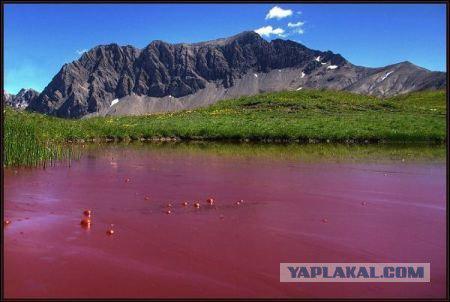
"Colourful" lakes scattered across the globe. To name just some of them and try to explain the reasons for their unusual coloring.
In the Carpathian Mountains near the village of bruises, near the town of Svaliava Transcarpathian region of Ukraine, at an altitude of 700 m above sea level is Lake bruise. Dissolved sulfur compounds therein give the water an intense blue color.
Especially a lot of lakes located in the Caucasus Mountains. So, near Lake Rizza has a small blue lake. Another blue lake is located in the gorge Chersky Kabardino-Balkaria. It affects a bright blue-green water, reminiscent of the copper sulfate solution. So dyed his salt water of various minerals and a large amount of hydrogen sulfide, which supplies the lake underground sources.
"Queen of the Lakes" for an amazing picturesque called the national poet of Azerbaijan Samed Vurgun lake Gek-Gel (ie, the "Blue Lake"), which is located at an altitude of 1576 m in the valley Asgunskom. Small in size (0, 8 sq. Km.), But quite deep (93 m), it is widely known to bright blue. So dyed his salt water of various minerals and a large amount of hydrogen sulfide, which is provided with its many streams.
Gek-Gel. Site News Photos Science

Many of the globe White lakes. In Russia alone, the name "White" has 20 lakes. Many of them spread out among forests and numerous rivers and lakes of the Vologda region, and are now a part of the Volga-Baltic waterway. It would seem that the lake as the lake, but when it is quite a large water mirror area of 1125 square meters. km, the wind tossing waves, as if it is covered by white horses. After all this time, eroding clay banks of the lake, the water takes on a whitish color.
On the island of Kunashir Island (Kuril Islands) is a milky-white lake even more intense color. Lake is boiling. It is established that it is filled with a concentrated solution of sulfuric and hydrochloric acids, and from the bottom of it all the time rising hot volcanic gases that heat the water to a boil.
White, but not boiling, lake known on the Indonesian island of Java and the Japanese islands.
Boiling Lake. Photo by Alexander Fetisov

In the south of the European part of Russia, in Western Siberia and Central Asia, there are many lakes with a purplish-red color of water. During sunset, they slightly change its color and how would resemble a bowl filled with molten gold. To this type belong to the lakes, such as saltwater lake known Lower Volga - Elton (in Kazakh Altyn-Nur means "Golden Lake»).
Elton. Photo copyright Nilsen.ru
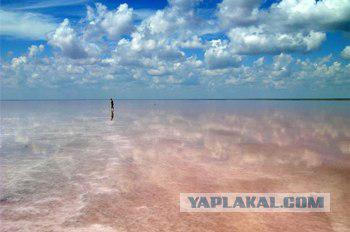
Near Astrakhan located "crimson" lake. They differ not only in color but also unusual, raspberry-like, aroma. That is why once the salt, which is extracted from these lakes in the amount of 100 pounds a year, was considered the best and comes exclusively to the table the Empress Catherine II. Painted in pale pink or orange color, which, however, the sun soon disappeared, she kept persistent aroma of raspberries or violets. These properties of the salt lakes are explained by the presence in their waters shallow salt-loving red-crustaceans Artemia. Otmiraya and decaying, and they give the unique smell of salt. These crustaceans are a favorite delicacy of flamingos.
Lake water pink to bright red in color and are known in the sands of the Karakum desert in line Uzboi and in Western Siberia. Raspberry widely known lake is located on the territory of Kulunda steppe in the south of Western Siberia. But not only painting distinguishes it among thousands of local lakes. The fact that the water of the lake at all times born and grow ... stone. As it turned out, the water in the lake is full of crimson magnesium salts and underground sources, its supply contain soda. Mixing these solutions and form a mass, which immediately hardens. Local people commonly use this extraordinary natural "plant of building materials", and in fact they are in a short supply steppe.
In some cases, the "culprits" pink color of water in the lake is purple bacteria.
Raspberry lake, Altay, Kulundinskaya steppe. Photo copyright Solnet.ee
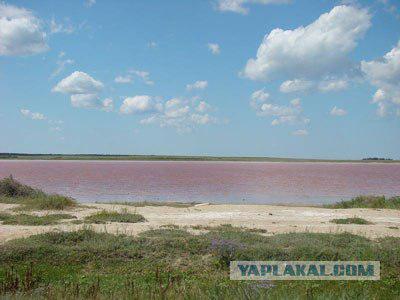
In the Italian Alps at an altitude of 1182 m above sea level is Lake Lago de Torvel. In sunny summer days when the lake water is heated to a temperature no lower than 16 degrees Celsius, it becomes red. This lake must actively breeding in this period peculiar microorganisms.
On the Japanese island of Kyushu, there is even a unique two-tone lake. One half of its sulfur impurities is painted in yellow, and the other - pink, since there are located on the bottom of the iron oxides.
Lake with red water are also found on the shores of the Mediterranean Sea in Western Europe. Similarly, a Colorado lake (meaning "Red"), as if abandoned in the height (4550 m) in the South American Cordillera (Bolivia).
Laguna Colorada, Bolivia. Photo copyright Travelpod.com
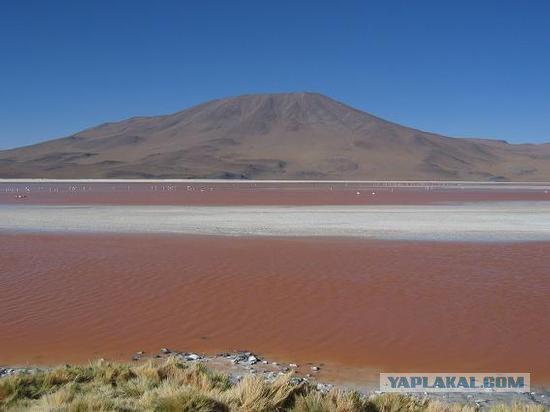
And yet, pink and red are not only salt lakes. One of these freshwater lakes - Red - located on the Karelian Isthmus in Russia. The color of its water due to the presence at the bottom of Lake iron formations.
The same type of lakes is owned and Japanese Kankaydzi lake, eating hot ferruginous water sources.
Name Sarykul or Sarikol meaning in Turkic "Yellow Lake" has a lot of lakes. Among them is the so-called Big Sarykul (an area of 100 sq. Km), located in the south of the Chelyabinsk region of Russia. Small Sarykul (50 sq. Km) is located in the east of Kazakhstan, Kustanai region. The water in these lakes for its color is more like a much diluted coffee due to the fact that it dissolved a lot of clay particles as a result of the constant erosion of beaches.
There in the Chelyabinsk region and the so-called Black Lake. Interestingly, iron smelted from the ore, which is mined nearby, does not rust. For a long time nobody could explain that it features. Now it found that the lake is located near the nickel deposit. It is and it affects both the color lake water, and the local quality ore.
Many "black lake" located in the European part of Russia, especially in Meshchersky lowland to the south-east of Moscow. The color of the water in them is explained by the presence of peat at the bottom, and than this peat is formed later, the darker the water in the lake. But perhaps one of the black lakes in the world is Lake Kahinaydaah located in Yakutia. The water of this lake is a kind of solution ... soot, ash and soot. The fact that Kahinaydaah is in a depression, where a few thousand years ago, a fire raged. There for many years burning coal deposit. Then a huge conflagration flooded water. She washed and dissolve all soot and smoke. Therefore, the water of the lake in its color like a liquid tar.
Interesting "color" the lake is well known in Algeria, near the town of Sidi Bel Abbes, among the picturesque mountains of the Atlas. The local population in the arid climate can appreciate even small sources of water, but the water of the lake, although it is not salty, not taking into irrigation canals, as well as is not used for drinking. I do not see it on the banks of a single fisherman. It turns out that the lake basin is not filled with water, and the actual ink. Only two small rivers flowing into it. But the water one of them saturated with iron salts, and the other, which flows through the marsh, contain residues of different vegetation. Mingling, they make a large natural lake in the inkwell.
Sidi Bel Abbes, Algeria. Photo copyright Latifa.ru

And here on the island of Flores in Indonesia, on top of a volcano, located not one, but three "color" of the lake, with water of different colors. In one of them the water bright red, the other - pale blue, and the third - as white as milk.
Lake in the crater of the volcano Keli Mutu, the island of Flores, Indonesia. Photo copyright Zmetravel.com
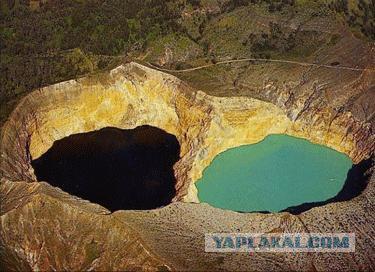
How do we explain the unusual colors of these lakes? It turns out that this blame the internal forces of the Earth and ... chemistry. The lake was formed in the crater of the volcano of different, rich in various minerals. In red, you guessed it, a lot of iron compounds, and the water here, "behaves" peacefully. In the blue and white lakes of salt solution of sulfuric and hydrochloric acid in different concentrations. The water is always boiling, and above the clouds of thick steam.
Tivu Ata Polo, the island of Flores, Indonesia. Photo copyright Rumbur.ru

Source:
Here, for example Blanca Lake, Washington, USA. Photo copyright Priroda.su
10 ph via web-malina

Some place names and even of foreign origin, but also in translation means color. For example, the Cabo Verde in Africa means "Cape Green" Greenland - "Green Country", the Black Forest, from which originates the Danube River - "Black Forest" Karatau Mountains in Central Asia - "Black Mountain", Mount Blanc in the Alps - the "White Mountain", Huang Ho River in China and Sarysu in Central Asia - "yellow" and Songkoy in Vietnam, the Red River and Colorado in the United States - "red" of the river, etc.
But especially a lot on the geographical map of so-called "colored" lakes. These lakes do have a variety of unusual shades of the water: red, magenta, blue-green, blue, yellow, white and even black.
Deep red lake Sanetsch Pass in Switzerland. Photo copyright Priroda.su

"Colourful" lakes scattered across the globe. To name just some of them and try to explain the reasons for their unusual coloring.
In the Carpathian Mountains near the village of bruises, near the town of Svaliava Transcarpathian region of Ukraine, at an altitude of 700 m above sea level is Lake bruise. Dissolved sulfur compounds therein give the water an intense blue color.
Especially a lot of lakes located in the Caucasus Mountains. So, near Lake Rizza has a small blue lake. Another blue lake is located in the gorge Chersky Kabardino-Balkaria. It affects a bright blue-green water, reminiscent of the copper sulfate solution. So dyed his salt water of various minerals and a large amount of hydrogen sulfide, which supplies the lake underground sources.
"Queen of the Lakes" for an amazing picturesque called the national poet of Azerbaijan Samed Vurgun lake Gek-Gel (ie, the "Blue Lake"), which is located at an altitude of 1576 m in the valley Asgunskom. Small in size (0, 8 sq. Km.), But quite deep (93 m), it is widely known to bright blue. So dyed his salt water of various minerals and a large amount of hydrogen sulfide, which is provided with its many streams.
Gek-Gel. Site News Photos Science

Many of the globe White lakes. In Russia alone, the name "White" has 20 lakes. Many of them spread out among forests and numerous rivers and lakes of the Vologda region, and are now a part of the Volga-Baltic waterway. It would seem that the lake as the lake, but when it is quite a large water mirror area of 1125 square meters. km, the wind tossing waves, as if it is covered by white horses. After all this time, eroding clay banks of the lake, the water takes on a whitish color.
On the island of Kunashir Island (Kuril Islands) is a milky-white lake even more intense color. Lake is boiling. It is established that it is filled with a concentrated solution of sulfuric and hydrochloric acids, and from the bottom of it all the time rising hot volcanic gases that heat the water to a boil.
White, but not boiling, lake known on the Indonesian island of Java and the Japanese islands.
Boiling Lake. Photo by Alexander Fetisov

In the south of the European part of Russia, in Western Siberia and Central Asia, there are many lakes with a purplish-red color of water. During sunset, they slightly change its color and how would resemble a bowl filled with molten gold. To this type belong to the lakes, such as saltwater lake known Lower Volga - Elton (in Kazakh Altyn-Nur means "Golden Lake»).
Elton. Photo copyright Nilsen.ru

Near Astrakhan located "crimson" lake. They differ not only in color but also unusual, raspberry-like, aroma. That is why once the salt, which is extracted from these lakes in the amount of 100 pounds a year, was considered the best and comes exclusively to the table the Empress Catherine II. Painted in pale pink or orange color, which, however, the sun soon disappeared, she kept persistent aroma of raspberries or violets. These properties of the salt lakes are explained by the presence in their waters shallow salt-loving red-crustaceans Artemia. Otmiraya and decaying, and they give the unique smell of salt. These crustaceans are a favorite delicacy of flamingos.
Lake water pink to bright red in color and are known in the sands of the Karakum desert in line Uzboi and in Western Siberia. Raspberry widely known lake is located on the territory of Kulunda steppe in the south of Western Siberia. But not only painting distinguishes it among thousands of local lakes. The fact that the water of the lake at all times born and grow ... stone. As it turned out, the water in the lake is full of crimson magnesium salts and underground sources, its supply contain soda. Mixing these solutions and form a mass, which immediately hardens. Local people commonly use this extraordinary natural "plant of building materials", and in fact they are in a short supply steppe.
In some cases, the "culprits" pink color of water in the lake is purple bacteria.
Raspberry lake, Altay, Kulundinskaya steppe. Photo copyright Solnet.ee

In the Italian Alps at an altitude of 1182 m above sea level is Lake Lago de Torvel. In sunny summer days when the lake water is heated to a temperature no lower than 16 degrees Celsius, it becomes red. This lake must actively breeding in this period peculiar microorganisms.
On the Japanese island of Kyushu, there is even a unique two-tone lake. One half of its sulfur impurities is painted in yellow, and the other - pink, since there are located on the bottom of the iron oxides.
Lake with red water are also found on the shores of the Mediterranean Sea in Western Europe. Similarly, a Colorado lake (meaning "Red"), as if abandoned in the height (4550 m) in the South American Cordillera (Bolivia).
Laguna Colorada, Bolivia. Photo copyright Travelpod.com

And yet, pink and red are not only salt lakes. One of these freshwater lakes - Red - located on the Karelian Isthmus in Russia. The color of its water due to the presence at the bottom of Lake iron formations.
The same type of lakes is owned and Japanese Kankaydzi lake, eating hot ferruginous water sources.
Name Sarykul or Sarikol meaning in Turkic "Yellow Lake" has a lot of lakes. Among them is the so-called Big Sarykul (an area of 100 sq. Km), located in the south of the Chelyabinsk region of Russia. Small Sarykul (50 sq. Km) is located in the east of Kazakhstan, Kustanai region. The water in these lakes for its color is more like a much diluted coffee due to the fact that it dissolved a lot of clay particles as a result of the constant erosion of beaches.
There in the Chelyabinsk region and the so-called Black Lake. Interestingly, iron smelted from the ore, which is mined nearby, does not rust. For a long time nobody could explain that it features. Now it found that the lake is located near the nickel deposit. It is and it affects both the color lake water, and the local quality ore.
Many "black lake" located in the European part of Russia, especially in Meshchersky lowland to the south-east of Moscow. The color of the water in them is explained by the presence of peat at the bottom, and than this peat is formed later, the darker the water in the lake. But perhaps one of the black lakes in the world is Lake Kahinaydaah located in Yakutia. The water of this lake is a kind of solution ... soot, ash and soot. The fact that Kahinaydaah is in a depression, where a few thousand years ago, a fire raged. There for many years burning coal deposit. Then a huge conflagration flooded water. She washed and dissolve all soot and smoke. Therefore, the water of the lake in its color like a liquid tar.
Interesting "color" the lake is well known in Algeria, near the town of Sidi Bel Abbes, among the picturesque mountains of the Atlas. The local population in the arid climate can appreciate even small sources of water, but the water of the lake, although it is not salty, not taking into irrigation canals, as well as is not used for drinking. I do not see it on the banks of a single fisherman. It turns out that the lake basin is not filled with water, and the actual ink. Only two small rivers flowing into it. But the water one of them saturated with iron salts, and the other, which flows through the marsh, contain residues of different vegetation. Mingling, they make a large natural lake in the inkwell.
Sidi Bel Abbes, Algeria. Photo copyright Latifa.ru

And here on the island of Flores in Indonesia, on top of a volcano, located not one, but three "color" of the lake, with water of different colors. In one of them the water bright red, the other - pale blue, and the third - as white as milk.
Lake in the crater of the volcano Keli Mutu, the island of Flores, Indonesia. Photo copyright Zmetravel.com

How do we explain the unusual colors of these lakes? It turns out that this blame the internal forces of the Earth and ... chemistry. The lake was formed in the crater of the volcano of different, rich in various minerals. In red, you guessed it, a lot of iron compounds, and the water here, "behaves" peacefully. In the blue and white lakes of salt solution of sulfuric and hydrochloric acid in different concentrations. The water is always boiling, and above the clouds of thick steam.
Tivu Ata Polo, the island of Flores, Indonesia. Photo copyright Rumbur.ru

Source:
Tags
See also
Home computer Atari 520STF
What exactly I hate some marketers - or as pros go shopping
Smart-ass marketing
Overview station Kaliningrad - Sorting (47 photos)
Known in Chinese Yap unit BOCOIN-6110
Pay attention! Made in Germany!
Several "smart" devices that are worth paying attention
This naive and touching retro-futurism
Pediatrician Gregory Sheyanov: How to recognize a child's medical emergency

















